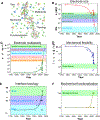Bioinspired Materials for In Vivo Bioelectronic Neural Interfaces
- PMID: 33103115
- PMCID: PMC7583599
- DOI: 10.1016/j.matt.2020.08.002
Bioinspired Materials for In Vivo Bioelectronic Neural Interfaces
Abstract
The success of in vivo neural interfaces relies on their long-term stability and large scale in interrogating and manipulating neural activity after implantation. Conventional neural probes, owing to their limited spatiotemporal resolution and scale, face challenges for studying the massive, interconnected neural network in its native state. In this review, we argue that taking inspiration from biology will unlock the next generation of in vivo bioelectronic neural interfaces. Reducing the feature sizes of bioelectronic neural interfaces to mimic those of neurons enables high spatial resolution and multiplexity. Additionally, chronic stability at the device-tissue interface is realized by matching the mechanical properties of bioelectronic neural interfaces to those of the endogenous tissue. Further, modeling the design of neural interfaces after the endogenous topology of the neural circuitry enables new insights into the connectivity and dynamics of the brain. Lastly, functionalization of neural probe surfaces with coatings inspired by biology leads to enhanced tissue acceptance over extended timescales. Bioinspired neural interfaces will facilitate future developments in neuroscience studies and neurological treatments by leveraging bidirectional information transfer and integrating neuromorphic computing elements.
Keywords: Biomimetics; brain implants; brain-machine interfaces; chronic stability; nanoelectronics; neural probes; neural recording; neural stimulation; spatiotemporal resolution; tissue-like electronics.
Conflict of interest statement
Declaration of interests The authors declare no competing interests.
Figures







References
-
- Song E, Li J, Won SM, Bai W, and Rogers JA (2020). Materials for flexible bioelectronic systems as chronic neural interfaces. Nat. Mater 19, 590–603. - PubMed
-
- Galvani L (1791). D viribus electricitatis in motu musculari: Commentarius. Bologna: Tip. Istituto delle Scienze, 1791; 58p.: 4 tavv. ft; in 4.; DCC. f. 70.
Grants and funding
LinkOut - more resources
Full Text Sources
